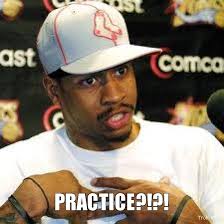I love golf practice and always have.
While I don't believe that range sessions in themselves will make you a better golfer, they are certainly an essential part of improving your game. I have never met a golfer who was able to lower their scores without practicing.
We're all not Allen Iverson.

One of the cornerstones of Practical Golf is that working on your game from inside 100 yards is the quickest way to lower your scores. Your wedge play and putting, can save you from almost anything in golf.
Our natural inclination is to take our drivers out of the bag and ignore our short game. Almost every golfer I have ever seen has fallen victim to this, myself included. It's fun to see how far we can hit the ball, but you need to resist this temptation if you genuinely want to get better.
Lacking focus in your golf practice sessions renders them almost useless
If you just go through the routine of hitting balls without thinking about what you are doing, I can guarantee you that you're not going to see any improvement on the course.
I feel that committing yourself to a specific time limit, or a ratio of time is the easiest way to combat this lack of focus. This is why I came up with a 20/20/20 system for myself.
Let me explain...
I believe that for most golfers, an hour is a perfect amount of time to do an excellent golf practice session. Now I know this might be more time than most of us can commit, but just use the ratio if you can only dedicate as little as 30 minutes (or 10 minutes per segment).
Segment 1: Chipping & Putting
Since I know we are all just dying to get to the driver, let's get the tedious work out of the way first. Kind of like how you promise a child a piece of candy if they do their chores.
For most of us, we have to force ourselves to practice our chipping and putting. This is precisely why I think you should start your first leg of golf practice working on these two elements. If you start with your longer clubs, you might never get around to it.
So for the first 20 minutes, or however long you have, work on your chipping around the green, and mostly putts inside of 10 feet (here's why). If you don't have access to practice at a golf course, then you might just have to make do with just the chipping element at the driving range.
You are going to be missing more greens than you hit, so you NEED to be able to chip proficiently to save par and bogey. Working on putts between 5-10 feet will help your confidence for those testy par saves as well.
Segment 2: Wedge Play
Wedges are the next area where you might have to force yourself before you get to the "fun." Your wedges are your best friends in golf. They can help you maneuver out of so many different situations, and prevent those blowup holes.
Mastering your wedges will lower your scores, no one can argue this point.
Start off with the awkward distances of 30-75 yards to help develop your feel (here is some help with technique). Then you can work your way up to your full swings with your sand, gap, and pitching wedges.
Most of your shots on the golf course will be from these distances. If you ignore them in your golf practice sessions, then you will lack confidence on the course. Mangling your wedges from 100, or even 50 yards, kills your momentum in your round. These are the shots where you have the best chance of getting it closer to the pin, not the ones from 150-200 yards out…so worry about these more!
Segment 3: Full Swings
Alright, now you can do your full swing.
Now that you have been sufficiently warmed up, and you have developed a nice feel with your wedge practice, I believe that your full swing will have a better tempo. You can work your way through the rest of the bag as you approach your longer irons/woods.
Please don't go directly to your driver, and here are a couple of reasons why:
- If you continually just hit your driver, you will probably ruin the tempo of your swing because you are just trying to hit it as far as possible.
- Developing confidence with a club less than driver off of the tee is a crucial element of course management, and you should devote some time on the range to this. You need to be able to take out a hybrid iron or 3 wood and feel good about your chances of hitting the fairway when things are not going well with your driver.
Every golf practice session needs a focus for it to be useful. I believe using this system is going to help prevent you from aimlessly hitting balls without a real plan.
If you liked this article, we have plenty more in-depth practice guides you can check out here:
How to practice your golf game at home
We care about the protection of your data Read our Privacy Policy